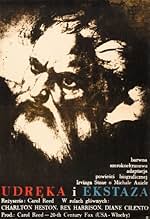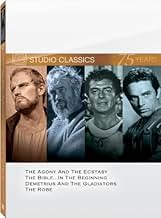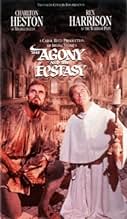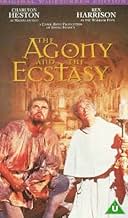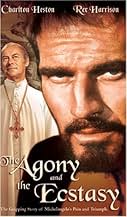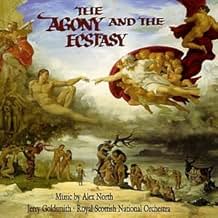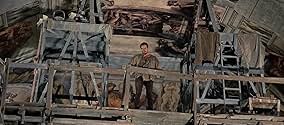CALIFICACIÓN DE IMDb
7.2/10
8.6 k
TU CALIFICACIÓN
La historia biográfica de los problemas de Miguel Ángel mientras pintaba la Capilla Sixtina a instancias del Papa Julio II.La historia biográfica de los problemas de Miguel Ángel mientras pintaba la Capilla Sixtina a instancias del Papa Julio II.La historia biográfica de los problemas de Miguel Ángel mientras pintaba la Capilla Sixtina a instancias del Papa Julio II.
- Nominado a 5 premios Óscar
- 3 premios ganados y 9 nominaciones en total
Fortunato Arena
- Pope's Bodyguard
- (sin créditos)
Lars Bloch
- Baron Von Silenen
- (sin créditos)
Angelo Boscariol
- Papal Guard
- (sin créditos)
Calisto Calisti
- Physician
- (sin créditos)
Amerigo Castrighella
- Quarry cart assistant
- (sin créditos)
Anita Ceccotti
- Woman Under the Chapel
- (sin créditos)
Enrico Chiappafreddo
- Tavern Customer
- (sin créditos)
- Dirección
- Guionistas
- Todo el elenco y el equipo
- Producción, taquilla y más en IMDbPro
Opiniones destacadas
I would be more generous than Maltin was with this one. I watched it again recently on tape and my impression improved over my first viewing. The production values are sumptuous, and the construction of a 1:1 mockup of the Sistine Chapel by Dino deLaurentis is a story in itself, evidently. Heston is pretty good as Michelangelo but is, I think, overshadowed by Harrison, who is just marvelous as Pope Julius (a previous commenter remarked on the historically inauthentic absence of his beard; in addition, Julius was too old & infirm too ride a horse into battle, but insisted on leading while carried on a litter). The conflicted interplay between Julius & Michelangelo is the core of the film, of course, and the script does its job well in this regard, particularly in the closing dialogue. It is interesting, though, to see how the movie dances around the issue of Michelangelo's purported homosexuality. We are so much more frank today (not necessarily for the better), and one shudders to consider how a contemporary movie would treat this subject (not that there's a chance in hell of a major movie being made today on the subject of the creation of one of the masterworks of Western Civilization's artistic achievements). If any movie definitely needs the letterbox format to show it off at its best, it is this one, so watch for it on TMC where it is often shown that way.
This is a fascinating, colorful and very-well made film that looks like an epic and is in fact an intelligent drama about sculptor-painter- architect-poet Michelangelo Buonarrotti. Here portrayed by the much taller Charlton Heston, and admirably, he is presented as a man who want only to create beauty, a man without "people skills" or interest in much of anything else--not women, nor war not the dynastic dreams of men--only the Renaissance idea of utilizing one's abilities. He even pays attention to religion only because the world interests him, and he equates his heaven with what men can achieve--and Earth with the same sort of place he expects to find as an afterlife. Carol Reed directed and produced this fascinating look at the Renaissance, with its warrior priests, its worldly dreamers and its subtle change toward a politics of gunpowder, secular pursuits and worldly morality. Philp Dunne, author of "David and Bathsheba" wrote this thoughtful spectacle film as well. In the cast besides Heston are Rex Harrison as Pope Julius, close-fisted patron, admirer and nemesis, Harry Andrews as his rival Bramante, Diane Cilento as the woman who would like to love him, Alberto Lupo, Adolfo Celli, Fausto Tozzi and a narration by Marvin Miller. The opportunity to see the real landscapes in which Michelangelo was born, worked and became inspired is a wonderful one for the viewer; the entire Carrara marble quarry section is stunningly beautiful. The film has battle scenes able done by Robert D. Webb, Leon Shamroy's cinematography, a prelude by Jerrald Goldsmith and sterling music by Alex North, production design by John Cuir and Jack Martin Smith and memorable costumes by Vittorio Nino Novarese. The basic thrust of the storyline is twofold; against the wars conducted by vigorous and all-too-worldly Pope Julius, the war to win secular hegemony for his Papal rule, the counter-current is Michelangelo's desire to further his career in Rome by obtaining a commission from the Pope. He does, an assignment to refurbish the Sistine Chapel for him. But after an attempt at some saints, he leaves Rome, and flees to his beloved Carrara. There, surrounded by mountains, he has a vision at sunset and suddenly knows what he must do. Obtaining Julius's reluctant permission, he sets to work covering that modest ceiling with tremendous figures, a bearded Jehovah, a recumbent Adam touched to life by a divine spark, the world's most famous fresco painted from a homemade scaffolding; in spite of illness, missed meals, filth, deprivation, cold, an injury that nearly costs him his eye and more, including the Pope's indifference to his intense passion for his art, Michelangelo endures. "When will you make an end?" Julius cries. "When I have done," the artist insists. And at the end, Julius, beaten on the field of battle, admits he may also have been wrong about the ceiling...that his fostering of Michelangelo's work may be the most important thing he has ever done. Of course the puritans of the era object to the nakedness the artist has depicted, but Michelangelo says he painted people as God made them. The movie, based on the biography "The Agony and the Ecstacy" by Irving Stone here concentrates on a seminal moment in the great artist's career. He may be a sculptor as he insists; but after seeing this moving and fascinating film, no one can doubt that he is also a stubborn and single-minded man--and a painter of genius. Most underrated; often fascinating fictionalized biography. Heston and Harrison are good, everyone else good as well. Worth seeing many times, if only for Dunne's dialogue and the scenery.
I like historical films. Recently I watched three historical films all made in the early 1960s. These are 'El Cid', 'The Spartacus' and 'The Agony and The Ecstasy'. Of the three, I rate The Agony and the Ecstasy as the best. This film is based on the eponymous novel written by Irving Stone. I had read the book nearly a decade back and it was nice to see the film finally. The film is about the circumstances under which Michelangelo came to compose his famous frescoes in the Sistine Chapel of Rome in the 16th century. The Sistine fresco, the 'creation of man' has become almost an emblem for the artist. But not many know that Michelangelo painted the Sistine frescoes reluctantly, only because he was forced to do so by his patron, Pope Julius II. The film is about the war of wits between these two great men Pope Julius II is a warrior pope, a worldly Pope. His concern is to protect the papal states from being over run by warring European powers. For this he is willing to take up arms. The pope knows that the posterity wont remember him for his spiritual prowess or leadership. Therefore he want to leave great works of art as his legacy. He therefore hires Michelangelo to paint the ceiling of the Sistine Chapel. The artist is not very keen on painting and considers sculpture to be his true calling. He is also not willing to conform to the prevailing canons of artistic excellence. He feels constrained by the limits of time and money that is set. All the great moments of the film occur when the Pope and the Artist clash. It is a clash of ideas and world views: (1) Whether sculpture is a superior form of art as compared to painting; (2) Whether it is appropriate depict biblical figures in their raw humanity; (3) Whether it is moral for a man of god to take arms for his principles and so on. For me the finest scene in the film is where the Pope and the Cardinals come to see the frescoes and judge it as lacking in good taste. The Artist is forced to give a strong rebuttal and in the process he expounds the humanist philosophy of art. Shot in beautiful Technicolor, the film still looks spectacular. It is a visual and intellectual treat.
like many historical films from the same age of Hollywood, the word "impressive" is the first to say. not only for its status of epic drama, costumes and the translation in image of a period. but, maybe , more important, for the admirable clash between Rex Harrison and Charlton Heston. and for the feel than a great story has its right and fair adaptation. because something impose "The Agony and the Ectasy" as special. not the biography of a great artist - and the admirable virtue is to know than Heston is Michelangelo not only act him - but the chance to discover yourself. the film, like the book, it is a beautiful eulogy to the life. using a genius as character of a kind of parable about art, proud, honesty and desire. so, just impressive. in this case - a word with deep roots.
The Agony and the Ecstasy is the story of the creation of the Sistine Chapel Roof painting, the time and money it took while Pope Julius II was busy establishing his Papacy as a political force.
Back in those days the Pope was far more than the head of the Roman Catholic Church. He ruled a considerable piece of real estate in the center of the Italian peninsula that were called the Papal States. They varied in geographic size depending on how relatively strong the Pope or his enemies were at a given time. The Papal States were the last independent entity to join a united Italy in 1870.
The Borgias had been nibbling away at the Papal States for years and their triumph became complete when one of their's became Pope Alexander VI in 1491. When Giuliano Della Rovere became Julius II in 1503 succeeding Alexander VI he had it in mind to reclaim the states from the Borgias and their backer the French monarchy. Those are the folks you see Rex Harrison fighting at the beginning of the film.
In fact Harrison's identity as the warrior Pope is made clear right at the beginning of the film when after we see this figure on a white horse killing some foes in battle, he takes off his helmet and some attendees put his papal vestments right over his armor.
But Julius II wanted to be known as a patron of the arts as well as the warrior Pope. His uncle Pope Sixtus VI had built the Sistine Chapel which is today the personal chapel of the papal residence. According to Wikipedia its dimensions are exactly what the Bible lays down as the dimensions King Solomon built his temple. But who knows what Solomon had decorating his roof.
It's a big bare spot and who to fill it with something good. Julius II decided on Michelangelo Buonarrati who's got quite a resume of creativity to recommend him even though it's mostly sculpture.
The film is the story of the creative differences between Michelangelo and Julius. Michelangelo is knowing he's created something for the ages, but he won't see the big picture of the here and now of Renaissance European politics which Julius II has to deal with.
Sir Carol Reed directed The Agony and the Ecstasy and does a marvelous job of creating the look and atmosphere of the Renaissance in Italy. Charlton Heston and Rex Harrison playing Michelangelo and the Pope give outstanding performances.
If the film has a weakness is that it really is a two man show with no other characters developed in any way. The rest of the mostly Italian cast just serve as a crowd.
If you're either a patron of the arts or a Catholic who would like to know how the Sistine Chapel acquired its legendary roof than by all means see The Agony and the Ecstasy.
Back in those days the Pope was far more than the head of the Roman Catholic Church. He ruled a considerable piece of real estate in the center of the Italian peninsula that were called the Papal States. They varied in geographic size depending on how relatively strong the Pope or his enemies were at a given time. The Papal States were the last independent entity to join a united Italy in 1870.
The Borgias had been nibbling away at the Papal States for years and their triumph became complete when one of their's became Pope Alexander VI in 1491. When Giuliano Della Rovere became Julius II in 1503 succeeding Alexander VI he had it in mind to reclaim the states from the Borgias and their backer the French monarchy. Those are the folks you see Rex Harrison fighting at the beginning of the film.
In fact Harrison's identity as the warrior Pope is made clear right at the beginning of the film when after we see this figure on a white horse killing some foes in battle, he takes off his helmet and some attendees put his papal vestments right over his armor.
But Julius II wanted to be known as a patron of the arts as well as the warrior Pope. His uncle Pope Sixtus VI had built the Sistine Chapel which is today the personal chapel of the papal residence. According to Wikipedia its dimensions are exactly what the Bible lays down as the dimensions King Solomon built his temple. But who knows what Solomon had decorating his roof.
It's a big bare spot and who to fill it with something good. Julius II decided on Michelangelo Buonarrati who's got quite a resume of creativity to recommend him even though it's mostly sculpture.
The film is the story of the creative differences between Michelangelo and Julius. Michelangelo is knowing he's created something for the ages, but he won't see the big picture of the here and now of Renaissance European politics which Julius II has to deal with.
Sir Carol Reed directed The Agony and the Ecstasy and does a marvelous job of creating the look and atmosphere of the Renaissance in Italy. Charlton Heston and Rex Harrison playing Michelangelo and the Pope give outstanding performances.
If the film has a weakness is that it really is a two man show with no other characters developed in any way. The rest of the mostly Italian cast just serve as a crowd.
If you're either a patron of the arts or a Catholic who would like to know how the Sistine Chapel acquired its legendary roof than by all means see The Agony and the Ecstasy.
¿Sabías que…?
- TriviaThe book on which this movie is based covers the entire life of Michelangelo Buonarroti. This movie based on a single chapter. One of the shortest, if not the shortest, in the entire book.
- ErroresAs shown in the movie, Michelangelo created a flat wooden platform on brackets built out from holes in the wall, high up near the top of the windows. But contrary to what is depicted in the film, he did not lie on this scaffolding while he painted, but painted from a standing position.
- ConexionesEdited from Prologue: The Artist Who Did Not Want to Paint (1965)
Selecciones populares
Inicia sesión para calificar y agrega a la lista de videos para obtener recomendaciones personalizadas
- How long is The Agony and the Ecstasy?Con tecnología de Alexa
Detalles
- Fecha de lanzamiento
- País de origen
- Idiomas
- También se conoce como
- The Agony and the Ecstasy
- Locaciones de filmación
- Piazza del Popolo, Todi, Perugia, Umbria, Italia(St. Peter's Square scene)
- Productora
- Ver más créditos de la compañía en IMDbPro
Taquilla
- Presupuesto
- USD 10,000,000 (estimado)
- Tiempo de ejecución
- 2h 18min(138 min)
- Color
- Relación de aspecto
- 2.20 : 1
Contribuir a esta página
Sugiere una edición o agrega el contenido que falta


